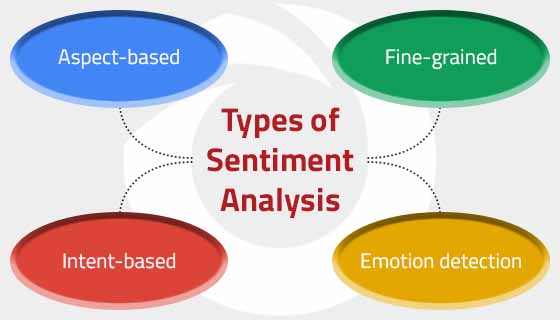Artificial intelligence | 20 Jan 2023 | 8 min
Top 4 Types of Sentiment Analysis

When you’re analyzing what works for your business and what doesn’t, you deal with two types of data- objective, tangible data that you collate from surveys, feedback, and reviews, and then there’s the subjective data revolving around your end user’s feelings. Is there a way for you to capture this subjective information and analyze it? Indeed! Sentiment analysis, also known as opinion mining, is an application of Natural Language Processing (NLP) and machine learning (ML) that helps you do just that!
If you’re looking to dive a little deeper into the what’s and how’s of sentiment analysis, I would urge you to go through our previous blogs for a quick refresher. The series has been divided into two parts – Part 1 and Part 2.
In this blog today, I will be speaking about the four types of sentiment analysis and highlighting their applications in the business world.

With this NLP task, the focus lies on identifying and extracting opinions pertaining to specific aspects of a given text. It is a more detailed version of traditional sentiment analysis where overall sentiment about a certain aspect is classified as positive, negative, or neutral.
Aspect-based sentiment analysis can be used in a wide variety of industries, including:
E-commerce– Identify specific aspects of a product that are liked or disliked by customers such as quality, design, price, etc.
Finance– Monitor specific aspects of a business that are on the radar of the investors such as growth prospects, financial statements, potential risks, etc.
Healthcare– Analyze certain aspects of healthcare enterprises that are being discussed by end customers such as treatment plans, medications, quality of care, etc.
Human resources– Make note of particular aspects of a company’s culture that are discussed such as job satisfaction, diversity, work-life balance, etc.
While aspect-based sentiment analysis focuses on particular aspects of text, fine grained analysis uses a lexicon approach to delve deeper into the sentiments expressed in a given text. It helps in identifying more specific sentiments based on intensity, emotions, and target.
Fine grained analysis can be used in several business applications, including:
This NLP task goes beyond identifying the tone (positive, negative, or neutral) of the given text and leveraged machine learning algorithms to understand the underlying purpose of the text. This could entail gauging whether the text is expressing a query, a complaint, a command, or a desire. Additionally, it also correctly identifies the sentiment of the text along with the degree to which it is expressed.
Intent-based sentiment analysis finds many applications in the business world, including:
This type of NLP task involves identifying information about the emotions expressed in a given text. It is more intricate than traditional sentiment analysis since it aims to understand the emotional state of the writer. It can deftly identify emotions such as anger, happiness, fear, and surprise.
Emotion detection sentiment analysis has a plethora of applications in the real world, including:

Reach out to us at Nitor Infotech to see how you too can tap into the true potential of sentiment analysis for your business!

we'll keep you in the loop with everything that's trending in the tech world.
